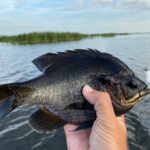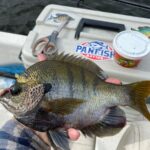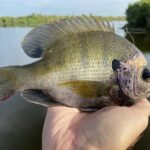Bluegill and crappie are both common panfish that are targeted by fishermen across North America that are oftentimes confused by inexperienced anglers.
It is important to correctly identify the differences between these fish in your local waters as fishing regulations may vary by location and apply to each species differently.
Below, I will explain everything you need to know to differentiate between bluegill and crappies.
I will also explain the basic differences in size, habitat, and behavior so that you can be more effective when targeting these fish!
Table of Contents
Bluegill vs Crappie: What’s the Confusion?
It isn’t hard to see why anglers struggle to tell these two species apart.
For one, the general body shape of the bluegill and crappie are very similar. This is because these fish are closely related. In fact, these two fish happen to be in the same family, the North American Sunfishes.
Secondly, both bluegill and crappie have a deep and round-shaped body of a panfish, both have sharp spines on their dorsal and anal fins, and they are similarly sized.
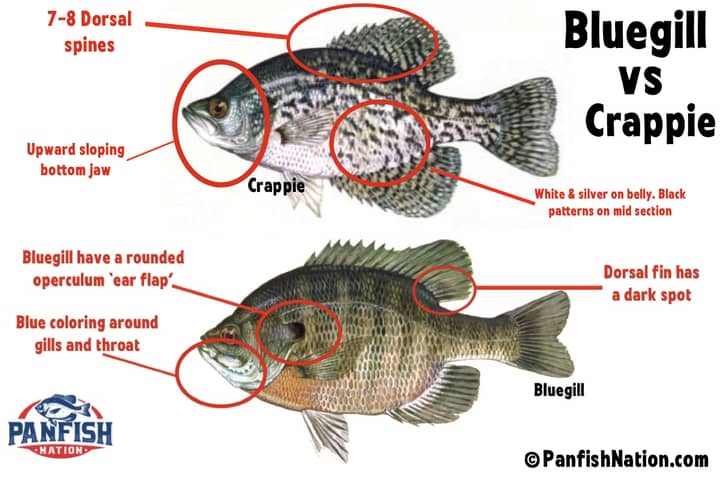
The ranges of these two fish are also very similar. Bluegill and crappie are both common and widespread throughout the freshwaters of North America.
They often live together in the same bodies of water, so you can catch them from the same lakes, ponds, and river systems.
How to Identify Crappie vs Bluegill
Bluegill and crappie can look really similar, but when compared side by side you can see some clear differences in color, patterns, shape, and size.
Here I will investigate some important features which will make it easy to tell them apart.
First, the colors and patterns are very different. Bluegill can be identified by the blue color on their gill cover, which they were named after. Just remember “Bluegill, blue gillls”. Bluegill are more colorful than crappie. Bluegill colors and patterns are also highly variable depending on the region, water conditions, sex, and time of year.
Bluegill (Lepomis macrochirus) have a light olive green to silver-blue colored body. They have some streaks of blues, grays, and even oranges. Some bluegill have bright orange-colored fins, and some bluegill will develop dark vertical bars along their body.
Since body color is so variable, the most obvious sign you’re dealing with a bluegill and not a crappie is a large solid black spot near the head of the fish. All bluegills have this black spot, known as the opercular flap, but it is often casually referred to as the ear of the sunfish, although it is not used for hearing.
If your fish has a spot on its opercular flap, but it is not solid black, your fish is probably a different species of sunfish, or maybe even a hybrid.
Crappie have a silvery to dark gray or black colored body. They have gray to green colored blotches that make up the unique chain-like patterns along their body. In darker waters, crappie can get some iridescent green flecks along their back.
When compared side by side, the bodies of bluegill and crappie are noticeably different. Bluegill are much deeper bodied and rounder than crappie which are more elongated in comparison.
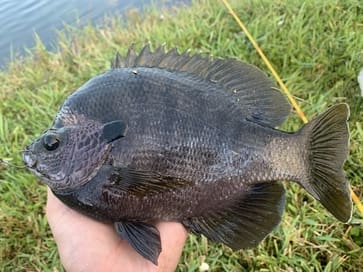
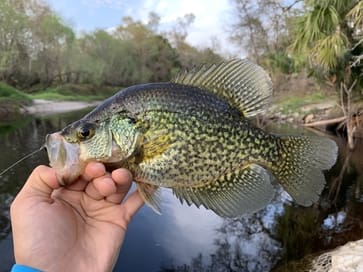
Photo courtesy of Species.Spotlight
If you’re still stumped with your fish, taking a closer look at the fins will surely point you in the right direction. The anal spine counts are different. Crappie have six anal spines and bluegill have three anal spines.
Size
The size of these two panfish is pretty similar, but when full-grown, crappie actually get larger than bluegill.
A full-grown bluegill is usually between about 8-10 inches long. Whereas a full-grown crappie is around 12-15 inches long.
There is also a big difference in weight. A bluegill over one pound is a really special fish, but crappies regularly reach over two pounds.
Habitat
Bluegill and crappie live in the same habitats. They can be found coexisting together in the same lakes, ponds, and river systems.
However, within these habitats, bluegill and crappie will favor different areas.
Crappie are a structure fish. They prefer to hang deeper and tighter to structure, such as submerged brush piles. If you’re targeting crappie, fish around submerged trees, edges of lily pads, and bridges. They will move between shallow and deep areas depending on the season and weather.
In the heat of the summer, crappie will move out deep to find cooler water where there is higher dissolved oxygen. In the winter and springtime, crappie will move up shallow getting ready to spawn.
Bluegill are an edge species. They prefer shallow to medium depth water usually around the edges of lakes, ponds, and rivers. They are typically associated with weedy vegetation and are often caught in 8 feet of water or less.
Feeding Habits
Bluegill and crappie are both opportunistic predators, and when in the feeding mood can eat a wide variety of prey. Bluegill can be incredibly aggressive, and they eat many different things.
Insects, insect larvae, worms, grass shrimp, crayfish, and even amphibians, such as small frogs or tadpoles are on the menu. Bluegill often feed up shallow, so it is common for land creatures, like grasshoppers, to fall into the water and get eaten off the surface.
Crappie have larger mouths so they can eat larger fish than bluegill, like shad, shiners, or silversides. Crappie will also eat insects, grass shrimp, and crayfish if the opportunity is there.
Use this to your advantage, keep a keen eye on the prey you observe, and match the hatch to improve your fishing!
Bluegill vs Crappie Taste
Bluegill and crappie are fun to catch, but you may be wondering, which species tastes better?
Crappie and bluegill are both good eating, but crappie are usually favored by anglers because they are larger. Their size makes it easier to get a clean filet and there’s more meat on the fish.
Crappie have a soft and flakey white-colored meat that is bland or slightly sweet in flavor. This is nice because they really take on whichever flavor you season it with.
Crappie is good fried or baked. They are good on their own, but they are especially tasty in a fish sandwich or in a taco.
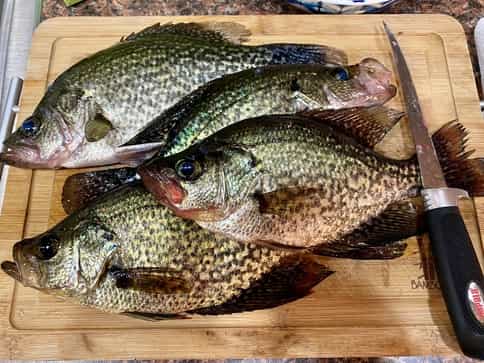
If you don’t mind working with a smaller fish, you will also enjoy eating bluegill.
Bluegill generally have sweeter tasting meat. Although they are small, it’s easy to catch lots of them and have plenty of food.
If you can catch the larger ones, you can fillet them. If you don’t want to bother filleting small fish, bluegill are really good deep-fried and eaten whole.
| Feature | Bluegill | Crappie |
|---|---|---|
| Size | Typically smaller, averaging 4-10 inches | Can grow larger, averaging 6-10 inches |
| Body shape | Round and flat | Elongated and thin |
| Coloration | Blue-green with orange underbelly | Silver with black spots |
| Habitat | Freshwater ponds, lakes, and streams | Freshwater ponds, lakes, and rivers |
| Diet | Insects, worms, and small fish | Insects, small fish, and crustaceans |
| Fishing technique | Often caught with small bait and bobber | Often caught with jigs or live bait near underwater structures |
| Taste | Mild and slightly sweet | Mild and flaky |
See Also: 3 Simple And Easy Panfish Recipes
Frequently Asked Questions
Will Crappie Eat Bluegill?
Crappie regularly feed on small fish, which may include juvenile bluegill or bluegill larvae. However adult bluegill do not make up a significant portion of the crappie diet.
Can Bluegill And Crappie Breed?
Although they are both members of the sunfish family there is no scientific evidence supporting that bluegill and crappie can crossbreed.
Can Crappie And Bluegill Live Together?
Crappie and bluegill can live together in the same body of water. Since they both prefer different habitats, this does not usually lead to a conflict except for on very small ponds, in which case the crappie may overpopulate.
Sunfish vs Bluegill vs Crappie?
There is a lot of confusion among the terms sunfish, bluegill, and crappie. The short answer is that both bluegill and crappie are members of the sunfish family (Centrarchidae), and both may be referred to as a sunfish as a ‘general’ term by anglers.
But a sunfish is not any one particular fish, it’s a generic term that typically refers to a small, deep-bodied panfish and its related species.
For More Information visit Bluegill vs Sunfish: Are They The Same?
Final Thoughts
Crappie and bluegill are arguably the two most popular panfish in North America.
Not only are they fun to catch, but they are delicious to eat and abundant in many states (and Canada too!)
Whether you are just getting started as an angler, or your an experienced veteran it’s always important to brush up on your fish identification skills.
By understanding the subtle variations between bluegill vs crappie, and their habits and preferences, you will become a more informed angler and a more successful angler.
Good luck!
You May Also Like: The top 10 Bluegill Lures of All Time
If you haven’t guessed yet, I love fishing and everything about it!
To learn more about why I started Panfish Nation, visit the About page and follow along on Social Media:


Download a copy of my FREE Lure Color Selection Chart & Knot Guide!
Stay up to date with fishing reports, tackle reviews, industry news, and much more! We respect your privacy, unsubscribe at any time.
Related Posts
- Crazy Facts About the World Record Crappie
- What Size Hooks for Smallmouth Bass? Quick Guide
- Large and in Charge-Mouth: 10 of the Best Bass Lures of All Time (And Where to Buy Them)
- Emperor of the Sun(fish): What You Need to Know About the World Record Bluegill
- Coppernose Bluegills: How They’re Different from Common Bluegill
- Bluegill vs Brim: Differences & Terminology, Explained!




